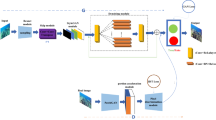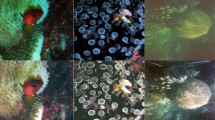Abstract
Enhancing image quality is crucial for achieving an accurate and reliable image analysis in vision-based automated tasks. Underwater imaging encounters several challenges that can negatively impact image quality, including limited visibility, color distortion, contrast sensitivity issues, and blurriness. Among these, depending on how the water filters out the different light colors at different depths, the color distortion results in a loss of color information and a blue or green tint to the overall image, making it difficult to identify different underwater organisms or structures accurately. Improved underwater image quality can be crucial in marine biology, oceanography, and oceanic exploration. Therefore, this paper proposes a novel Generative Adversarial Network (GAN) architecture for underwater image enhancement, restoring good perceptual quality to obtain a more precise and detailed image. The effectiveness of the proposed method is evaluated on the EUVP dataset, which comprises underwater image samples of various visibility conditions, achieving remarkable results. Moreover, the trained network is run on the RPi4B as an embedded system to measure the time required to enhance the images with limited computational resources, simulating a practical underwater investigation setting. The outcome demonstrates the presented method applicability in real-world underwater exploration scenarios.
Access this chapter
Tax calculation will be finalised at checkout
Purchases are for personal use only
Similar content being viewed by others
References
Avola, D., Bernardi, M., Cinque, L., Foresti, G.L., Massaroni, C.: Adaptive bootstrapping management by keypoint clustering for background initialization. Pattern Recognit. Lett. 100, 110–116 (2017). https://doi.org/10.1016/j.patrec.2017.10.029
Avola, D., et al.: A novel GAN-based anomaly detection and localization method for aerial video surveillance at low altitude. Remote Sens. 14(16), 4110 (2022). https://doi.org/10.3390/rs14164110
Avola, D., Cascio, M., Cinque, L., Fagioli, A., Foresti, G.L.: Affective action and interaction recognition by multi-view representation learning from handcrafted low-level skeleton features. Int. J. Neural Syst. 2250040 (2022). https://doi.org/10.1142/s012906572250040x
Avola, D., Cinque, L., De Marsico, M., Fagioli, A., Foresti, G.L.: LieToMe: preliminary study on hand gestures for deception detection via fisher-LSTM. Pattern Recognit. Lett. 138, 455–461 (2020). https://doi.org/10.1016/j.patrec.2020.08.014
Avola, D., Cinque, L., Fagioli, A., Foresti, G.L., Fragomeni, A., Pannone, D.: 3d hand pose and shape estimation from RGB images for keypoint-based hand gesture recognition. Pattern Recognit. 129, 108762 (2022). https://doi.org/10.1016/j.patrec.2017.10.029
Avola, D., Cinque, L., Fagioli, A., Foresti, G., Mecca, A.: Ultrasound medical imaging techniques: a survey. ACM Comput. Surv. 54(3), 1–38 (2021). https://doi.org/10.1145/3447243
Avola, D., Cinque, L., Foresti, G.L., Pannone, D.: Automatic deception detection in RGB videos using facial action units. In: International Conference on Distributed Smart Cameras, pp. 1–6 (2019). https://doi.org/10.1145/3349801.3349806
Avola, D., Foresti, G.L., Martinel, N., Micheloni, C., Pannone, D., Piciarelli, C.: Real-time incremental and geo-referenced mosaicking by small-scale UAVs. In: Battiato, S., Gallo, G., Schettini, R., Stanco, F. (eds.) ICIAP 2017. LNCS, vol. 10484, pp. 694–705. Springer, Cham (2017). https://doi.org/10.1007/978-3-319-68560-1_62
Avola, D., Petracca, A., Placidi, G.: Design of a framework for personalised 3d modelling from medical images. Comput. Methods Biomech. Biomed. Eng. Imaging Vis. 3(2), 76–83 (2015). https://doi.org/10.1080/21681163.2013.853622
Berman, D., Levy, D., Avidan, S., Treibitz, T.: Underwater single image color restoration using haze-lines and a new quantitative dataset. IEEE Trans. Pattern Anal. Mach. Intell. 43(8), 2822–2837 (2021). https://doi.org/10.1109/TPAMI.2020.2977624
Budzan, S., et al.: Using gesture recognition for AGV control: preliminary research. Sensors 23(6), 3109 (2023). https://doi.org/10.3390/s23063109
Cho, Y., Jeong, J., Kim, A.: Model-assisted multiband fusion for single image enhancement and applications to robot vision. IEEE Robot. Autom. Lett. 3(4), 2822–2829 (2018). https://doi.org/10.1109/LRA.2018.2843127
Dzedzickis, A., Kaklauskas, A., Bucinskas, V.: Human emotion recognition: review of sensors and methods. Sensors 20(3), 592 (2020). https://doi.org/10.3390/s20030592
Elhoseny, M.: Multi-object detection and tracking (MODT) machine learning model for real-time video surveillance systems. Circuits Syst. Signal Process. 39, 611–630 (2020)
Fabbri, C., Islam, M.J., Sattar, J.: Enhancing underwater imagery using generative adversarial networks. In: IEEE International Conference on Robotics and Automation, pp. 7159–7165 (2018). https://doi.org/10.1109/ICRA.2018.8460552
Guo, Y., Li, H., Zhuang, P.: Underwater image enhancement using a multiscale dense generative adversarial network. IEEE J. Ocean. Eng. 45(3), 862–870 (2020). https://doi.org/10.1109/JOE.2019.2911447
Islam, M.J., Ho, M., Sattar, J.: Understanding human motion and gestures for underwater human-robot collaboration. J. Field Robot. 36(5), 851–873 (2019). https://doi.org/10.1002/rob.21837
Islam, M.J., Xia, Y., Sattar, J.: Fast underwater image enhancement for improved visual perception. IEEE Robot. Autom. Lett. 5(2), 3227–3234 (2020). https://doi.org/10.1109/LRA.2020.2974710
Kang, Z., Yang, J., Yang, Z., Cheng, S.: A review of techniques for 3d reconstruction of indoor environments. ISPRS Int. J. Geo-Inf. 9(5), 330 (2020). https://doi.org/10.3390/ijgi9050330
Li, C., Guo, J., Guo, C.: Emerging from water: underwater image color correction based on weakly supervised color transfer. IEEE Signal Process. Lett. 25(3), 323–327 (2018). https://doi.org/10.1109/LSP.2018.2792050
Li, H., Zhuang, P.: DewaterNet: a fusion adversarial real underwater image enhancement network. Signal Process. Image Commun. 95, 116248 (2021). https://doi.org/10.1016/j.image.2021.116248
Li, H., Zhuang, P., Wei, W., Li, J.: Underwater image enhancement based on dehazing and color correction. In: IEEE International Conference on Parallel Distributed Processing with Applications, Big Data Cloud Computing, Sustainable Computing Communications, Social Computer and Networking, pp. 1365–1370 (2019). https://doi.org/10.1109/ISPA-BDCloud-SustainCom-SocialCom48970.2019.00196
Li, J., Skinner, K.A., Eustice, R.M., Johnson-Roberson, M.: WaterGAN: unsupervised generative network to enable real-time color correction of monocular underwater images. IEEE Robot. Autom. Lett. 3(1), 387–394 (2018). https://doi.org/10.1109/LRA.2017.2730363
Liu, Y., Rong, S., Cao, X., Li, T., He, B.: Underwater single image dehazing using the color space dimensionality reduction prior. IEEE Access 8, 91116–91128 (2020). https://doi.org/10.1109/ACCESS.2020.2994614
Petit, F., Capelle-Laize, A.S., Carre, P.: Underwater image enhancement by attenuation inversion with quaternions. In: IEEE International Conference on Acoustic Speech Signal Process, pp. 1177–1180 (2009). https://doi.org/10.1109/ICASSP.2009.4959799
Ronneberger, O., Fischer, P., Brox, T.: U-Net: convolutional networks for biomedical image segmentation. In: Navab, N., Hornegger, J., Wells, W.M., Frangi, A.F. (eds.) MICCAI 2015. LNCS, vol. 9351, pp. 234–241. Springer, Cham (2015). https://doi.org/10.1007/978-3-319-24574-4_28
Sharma, P., et al.: Student engagement detection using emotion analysis, eye tracking and head movement with machine learning. In: Reis, A., Barroso, J., Martins, P., Jimoyiannis, A., Huang, R.YM., Henriques, R. (eds.) TECH-EDU 2022. CCIS, vol. 1720, pp. 52–68. Springer, Cham (2023). https://doi.org/10.1007/9783031229183_5
Wang, J., et al.: CA-GAN: class-condition attention GAN for underwater image enhancement. IEEE Access 8, 130719–130728 (2020). https://doi.org/10.1109/ACCESS.2020.3003351
Xiong, J., Zhuang, P., Zhang, Y.: An efficient underwater image enhancement model with extensive Beer-Lambert law. In: IEEE International Conference on Image Processing (ICIP), pp. 893–897 (2020). https://doi.org/10.1109/ICIP40778.2020.9191131
Ye, X., Xu, H., Ji, X., Xu, R.: Underwater image enhancement using stacked generative adversarial networks. In: Pacific Rim Conference on Multimedia (PCM), pp. 514–524 (2018). https://doi.org/10.1007/9783030007645_47
Zhou, J.T., Du, J., Zhu, H., Peng, X., Liu, Y., Goh, R.S.M.: AnomalyNet: an anomaly detection network for video surveillance. IEEE Trans. Inf. Forensics Secur. 14(10), 2537–2550 (2019). https://doi.org/10.1109/TIFS.2019.2900907
Zhou, S.K., et al.: A review of deep learning in medical imaging: imaging traits, technology trends, case studies with progress highlights, and future promises. Proc. IEEE 109(5), 820–838 (2021). https://doi.org/10.1109/JPROC.2021.3054390
Zhu, J.Y., Park, T., Isola, P., Efros, A.A.: Unpaired image-to-image translation using cycle-consistent adversarial networks. In: IEEE International Conference on Computer Vision (ICCV), pp. 2223–2232 (2017)
Acknowledgements
This work was supported by “Smart unmannEd AeRial vehiCles for Human likE monitoRing (SEARCHER)” project of the Italian Ministry of Defence (CIG: Z84333EA0D); and “A Brain Computer Interface (BCI) based System for Transferring Human Emotions inside Unmanned Aerial Vehicles (UAVs)” Sapienza Research Projects (Protocol number: RM1221816C1CF63B); and “DRrone Aerial imaGe SegmentatiOn System (DRAGONS)” (CIG: Z71379B4EA); and Departmental Strategic Plan (DSP) of the University of Udine - Interdepartmental Project on Artificial Intelligence (2020–25); and “An Integrated Platform For Autonomous Agents For Maritime Situational Awareness (ARGOS)” project of the Italian Ministry of Defence (PNRM 2022); and the MICS (Made in Italy - Circular and Sustainable) Extended Partnership and received funding from Next-Generation EU (Italian PNRR - M4 C2, Invest 1.3 - D.D. 1551.11-10-2022, PE00000004). CUP MICS B53C22004130001.
Author information
Authors and Affiliations
Corresponding author
Editor information
Editors and Affiliations
Rights and permissions
Copyright information
© 2023 The Author(s), under exclusive license to Springer Nature Switzerland AG
About this paper
Cite this paper
Avola, D. et al. (2023). Real-Time GAN-Based Model for Underwater Image Enhancement. In: Foresti, G.L., Fusiello, A., Hancock, E. (eds) Image Analysis and Processing – ICIAP 2023. ICIAP 2023. Lecture Notes in Computer Science, vol 14233. Springer, Cham. https://doi.org/10.1007/978-3-031-43148-7_35
Download citation
DOI: https://doi.org/10.1007/978-3-031-43148-7_35
Published:
Publisher Name: Springer, Cham
Print ISBN: 978-3-031-43147-0
Online ISBN: 978-3-031-43148-7
eBook Packages: Computer ScienceComputer Science (R0)




